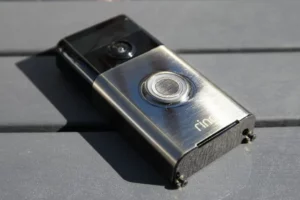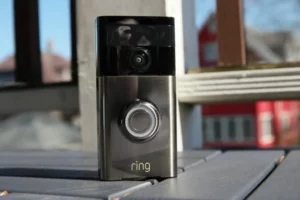According to the marketing, the Ring Doorbell boasts easy installation. All you need to do is attach the mounting bracket, hook the doorbell over it, and secure it with the provided security screws – and your setup is complete, as simple as that. Once installed, the wide-angle lens ensures it captures a comprehensive view of your visitors, including their faces, which is quite impressive. However, if you happen to have a narrow or awkwardly-shaped door frame, there are a few tricks to ensure a successful installation.
To tackle such situations, using wedge or corner kits becomes essential, especially with narrow setups. Opting for the thinnest Ring model, like the Pro, is also advisable in these cases. Nevertheless, it’s important to remain cautious, as you could still face challenges with video captures, either leading to poor quality or even obscured footage if not careful during the setup process.
Why it’s A Problem for Ring Doorbells In A Narrow Space?
Ring doorbells are renowned for their ability to capture a comprehensive view of the outside, thanks to their wide-angle lens, which is a significant selling point. However, this feature also brings about a couple of challenges:

Problem 1: Inset Door Placement One issue arises when your door and its frame are set back into the wall more than a few inches, like in the following scenarios:
- A close-up view of a thin UPVC door frame panel, with a brick wall to the left, causing significant obstruction in the wide-angle lens video capture.
- An even more extreme example, where the level of door inset would obstruct a large portion of potentially useful Ring footage.
In such cases, a substantial portion of the captured video may predominantly show the adjacent wall rather than your visitors. Consequently, this could create blind spots, allowing a well-informed intruder to approach your property from the side the Ring cannot capture. This becomes particularly problematic when the door is deeply inset without a porch, as the Ring will only capture the intruder’s body once they are right in front of the door, making it difficult to identify them.
To address this issue, refer to Solutions 1 and 2 outlined below.
Problem 2: Thin or Narrow Door Frames The Ring Doorbell 2 measures 2.5 inches (6.35cm) in width. While this typically fits the average door frame, it becomes problematic if your door frame is narrower than this measurement, as demonstrated in the following scenario:
A narrow door frame with a protruding wall, which significantly obstructs the Ring’s video capture.
Here, the door frame’s width is less than 2 inches (5cm), falling below the minimum width requirement for the Ring Doorbell 2. The Ring Doorbell 1 has a slightly smaller width at 2.4 inches (6.17cm), but it can still face similar challenges. The presence of an internal battery in these models, intended for non-hardwired use, adds bulkiness to the unit, making it wider and exacerbating the issue.
For solutions to address these problems, please refer to Solutions 1 and 2 below.
Solutions to Narrow Installs
Solution 1
Use a Corner Kit If your door is inset from the wall, a corner kit or angle mount can be quite effective. This accessory allows you to change the Ring’s direction, altering the field of video capture. By using the corner kit, you can avoid capturing a significant portion of the adjacent wall in the video and obtain a clear view of your visitors instead. These kits typically offer a tilt range of 30-50 degrees, making them useful for adjusting the capture angle to your preference.
Additionally, the corner kit can be beneficial if you want to improve the view of people approaching your house from the street, particularly if you live at the end of a street. Adjusting the Ring’s angle in this direction will provide more useful video coverage.

Solution 2
Use a Wedge Kit In cases where you can’t install the Ring at the recommended height (48 inches/121 cm off the ground) due to obstructions or the existing doorbell’s placement, a wedge kit can be helpful. This accessory allows you to tilt the Ring vertically, capturing more of the desired view, such as approaching visitors, and less of unwanted areas like the road and neighboring houses.
Ring offers an official wedge tilt kit with stackable wedges, enabling 5-15% vertical tilt adjustments to suit your specific needs.
Solution 3
Opt for Ring Doorbell Pro 1/2 or Wired Models If your door frame is too narrow to accommodate battery-powered Ring Doorbell models (e.g., Ring 1, 2, 3, and 4), it might be best to consider alternatives.
The battery-powered versions tend to be bulkier compared to hardwired models like Ring Doorbell Pro 1, Pro 2, or Wired. These slimmer options are suitable if you can hardwire them, providing a more suitable fit for narrow door frames.
Solution 4
Mount on the Main Wall (Not the Door Frame) If there isn’t enough space to install the Ring Doorbell on the door frame, another option is to mount it on the main wall next to your door. This can work well, especially for battery-powered models like Ring Doorbell 1 and 2, as they don’t require hardwiring.
However, if you want to hardwire it and lack an existing doorbell on the wall, it could be challenging due to the need to run cables through the wall. Be cautious not to mount it too far from the door, as it may not capture visitors properly, and some visitors might not notice it and knock on your door instead.
Solution 5
Mount on the Door Continuing from Solution 4, installing the Ring Doorbell on the door itself is another viable option if mounting it on the door frame isn’t feasible.
This approach works well for battery-powered models but not for hardwired installations since the cables would interfere with the door’s movement. When attached to the door, centrally mounting the doorbell provides better video captures, showing visitors more centrally in the videos rather than on one side.

Solution 6
Consider a Peephole Cam If the previous solutions are not possible or you’re unable or unwilling to drill into your house’s exterior, the Ring Peephole Cam (also known as the Ring Door View Cam) can be an alternative. This device replaces your door’s peephole and functions like the Ring Doorbell Pro, providing two-way communication, motion-activated notifications, and HD video.
The advantage of this option is that it is installed inside your property, making it harder to steal or tamper with. However, please note that the Ring Peephole Cam may not be widely available, as it has been discontinued by Ring. You might still find second-hand or excess stock options in some stores.
Wrapping it up
In conclusion, while Ring doorbells offer excellent wide-angle lens capabilities to capture a comprehensive view of the outside, certain challenges may arise depending on the specific installation scenario. For those facing issues with an inset door or a narrow door frame, various solutions can be employed to optimize video captures and ensure security isn’t compromised.
The use of corner kits or angle mounts can effectively overcome problems with inset doors, allowing users to adjust the Ring’s direction and obtain clear footage of visitors without obstructing walls. Additionally, wedge kits prove beneficial when the recommended installation height is impractical, enabling vertical tilt adjustments for capturing the desired view.
For those with narrow door frames, opting for slim and hardwired Ring models, such as the Ring Doorbell Pro 1, Pro 2, or Wired, can be a suitable solution, offering a better fit and enhanced video coverage.
If conventional mounting options aren’t feasible, installing the Ring on the main wall or directly on the door can still provide viable alternatives, although certain considerations, such as cabling or visibility, should be kept in mind.
Lastly, the Ring Peephole Cam serves as a potential alternative for those unable to drill into their property’s exterior, offering smart camera features without compromising on security.
Ultimately, the key is to assess the specific installation scenario and choose the appropriate solution that best accommodates the doorbell’s positioning while maximizing its video capture capabilities. By addressing these challenges, users can fully leverage the security features of their Ring doorbells and ensure enhanced protection for their homes and properties.
You May Also Enjoy Reading: Ring Recordings Have Strange Lights Or Orbs At Night

